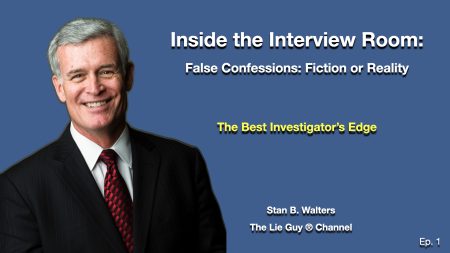Interview and Interrogation Techniques
Lie Signs and Hen’s Teeth
What Interviewers and Interrogators may be missing
Stan B. Walters
For nearly 50 years flawed interview and interrogation techniques training has fostered the belief that those people who commit the act of deception will exhibit a plethora of telltale non-verbal cues. Interview and interrogation techniques courses have taught over five decades that fidgeting, grooming, hand wringing, sweating, breaks in eye contact and even eye movement were just some of the purported undeniable cues that someone was lying. Unfortunately the overwhelming results of empirical research on deception, has debunked a very large majority of non-verbal cues as reliable signs of deception.
Body Language Cues Are Not Working
Several empirical studies confirm that focusing on body language results in poor detection of deception. Lie signs that subjects may generate during interviewing and interrogation are apparently rare and very faint signals. This is most likely the very reason the majority of people including interviewers and interrogators tend to perform very poorly at spotting deception.
Free ebook Practical Kinesic Interview & Interrogation®: A Basic Guide
Big Foot is alive and well! Not!
Peer reviewed research published by Aldert Virj has shown that people in fact do not generate what he calls “stereotypical signs” of nervousness behavior during their attempt to deceive. He found this to be true even though the individual may be experiencing a high level of “detection anxiety” or the fear of getting caught lying.
Virj further found that investigators who focused primarily on the body language cues during interviewing and interrogation to spot deception developed a very strong “lie bias.” In empirical research, this is referred to as “confirmation bias.” This is especially true for the multitude of body language myths perpetuated in law enforcement academy training materials. If you think you’re going prove that Big Foot exists, then every single snapped twig or unusual noise in the woods is a sign that Big Foot is real.
Could Verbal Cues Be More Reliable?
When put to the test, in general interviewers and interrogators who focus more on speech cues for diagnosing deception perform better than those watching for the myth-based body language cues. However, another contributing factor to missing verbal cues to deception are the many myths about verbal signs of deception. Such cues as stuttering, stammering, stalling, “ah” “er” “um” and “uh”, laughing, voice pitch and many many more have been proven unreliable.
Hen’s Teeth and Lie Signs
It would appear that verbal and nonverbal signs of deception are quite rare. To complicate matters even more, they have a very short duration which overall makes them hard to spot. Ekman, et al and their work on micro expressions have overwhelming proved that point. The job of the interviewer therefore is cover topics thoroughly and perhaps even repetitively.
If the interviewer or interrogator hopes to spot any signs of deception, then they need to focus more not only on what they hear but also ask questions that are very focused and will energize the subject’s efforts to maintain deception making the cues stand out. In other words, the better the questions and the more thorough the coverage the better chance the interviewer will have at spotting deception. Otherwise deception cues from a subject will be as rare as hen’s teeth!
Watch Stan’s You Tube Video on Hen’s Teeth & Lie Signs

